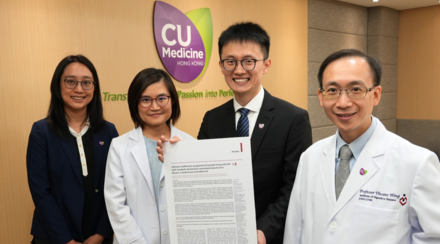CUHK Estimates One Million Hong Kong People are Suffering from Fatty Liver Disease
Non-alcoholic fatty liver disease (NAFLD) is the most common liver disease worldwide. Previous studies from The Chinese University of Hong Kong (CUHK) indicated that 25% of NAFLD patients had worsening of liver fibrosis in 3 years. Some may even progress to cirrhosis and liver cancer. NAFLD is also strongly associated with metabolic syndrome (diabetes, hypertension, central obesity and dyslipidemia) and coronary artery disease. Therefore, epidemiological studies on NAFLD are very important.
Most previous epidemiological studies used ultrasound scan for assessment in the past. However, ultrasound can only detect fatty liver when over 30% of liver cells have fat accumulation. It also cannot assess the severity of NAFLD. Hence, the current knowledge on the epidemiology of NAFLD is incomplete. With the advancement of new technology, it is possible to evaluate the liver more quickly and accurately nowadays. From 2008 to 2010, the Center for Liver Health at CUHK had conducted a population screening study to obtain more accurate epidemiological data.

(from left) Professor Henry Lik Yuen CHAN, Director, Centre for Liver Health and Professor, Department of Medicine & Therapeutics, CUHK and Professor Vincent Wai Sun WONG, Associate Professor, Department of Medicine & Therapeutics, CUHK.
3,000 local citizens were selected randomly from the general population and 922 completed the assessments as follow:
- Proton-magnetic resonance spectroscopy: An accurate method to detect mild to severe fatty liver
- Fibroscan®: A non-invasive test to detect liver fibrosis and cirrhosis
Among 922 subjects, 264 (28.6%) were found to have fatty liver. After excluding subjects with significant alcohol consumption, the prevalence of NAFLD remained high at 27.3%. Besides, 3.7% of the fatty liver subjects have already had severe liver fibrosis or cirrhosis. Based on these figures, around 1 million adults in Hong Kong are estimated to have NAFLD, and over 40,000 may even have severe liver fibrosis or cirrhosis. From previous studies, the latter high risk group is at risk of disease progression, and 20-30% may eventually die from liver cancer or cirrhotic complications. The study indicated that the situation of NAFLD is alarming in Hong Kong.
In addition, NAFLD patients have a higher risk of metabolic syndrome. 47% of NAFLD patients, compared to only 9% of controls, had metabolic syndrome.
2.3% of modest drinkers (alcohol intake of less than 10g per day) and 1.7% of non-drinkers had severe fibrosis or cirrhosis. Therefore, drinking less than 10g per day, i.e. around 1 glass of beer or red wine, does not increase the risk of liver disease.
In conclusion, a quarter of Hong Kong adults suffer from NAFLD. Over 40,000 people also have severe fibrosis or cirrhosis. NAFLD patients are at risk of metabolic syndrome. Modest alcohol intake does not cause liver injury. Therefore, CUHK recommends adults, especially those with metabolic syndrome, to undergo liver assessment. NAFLD patients should adopt a healthy lifestyle.























